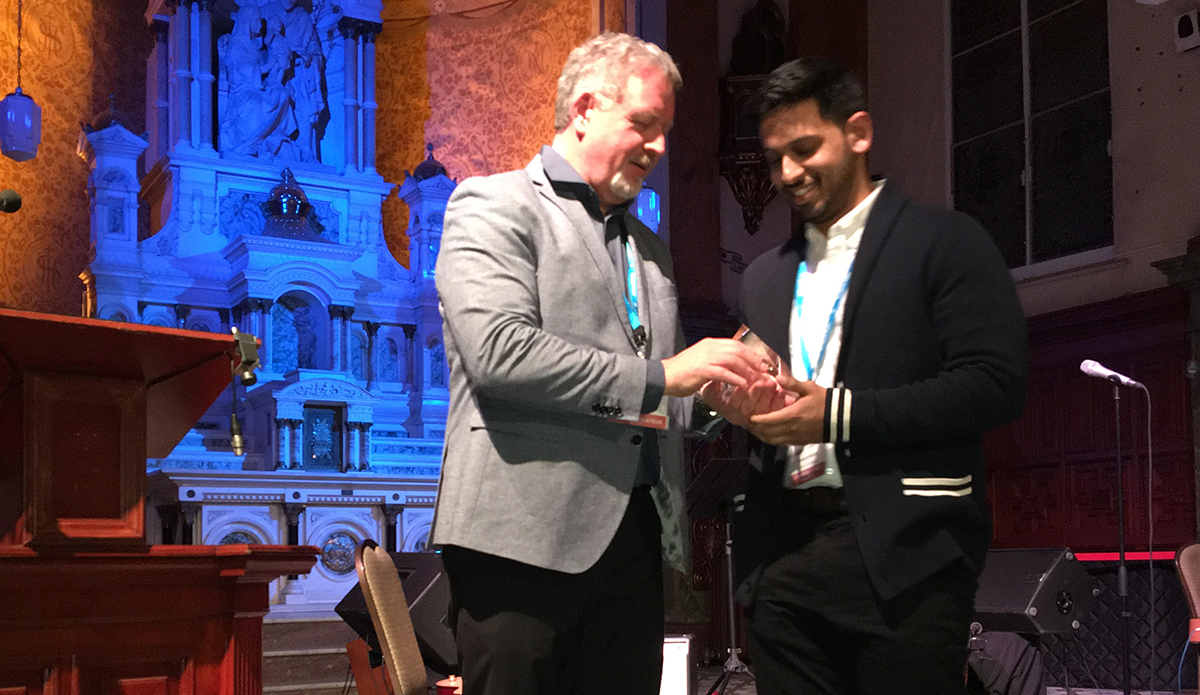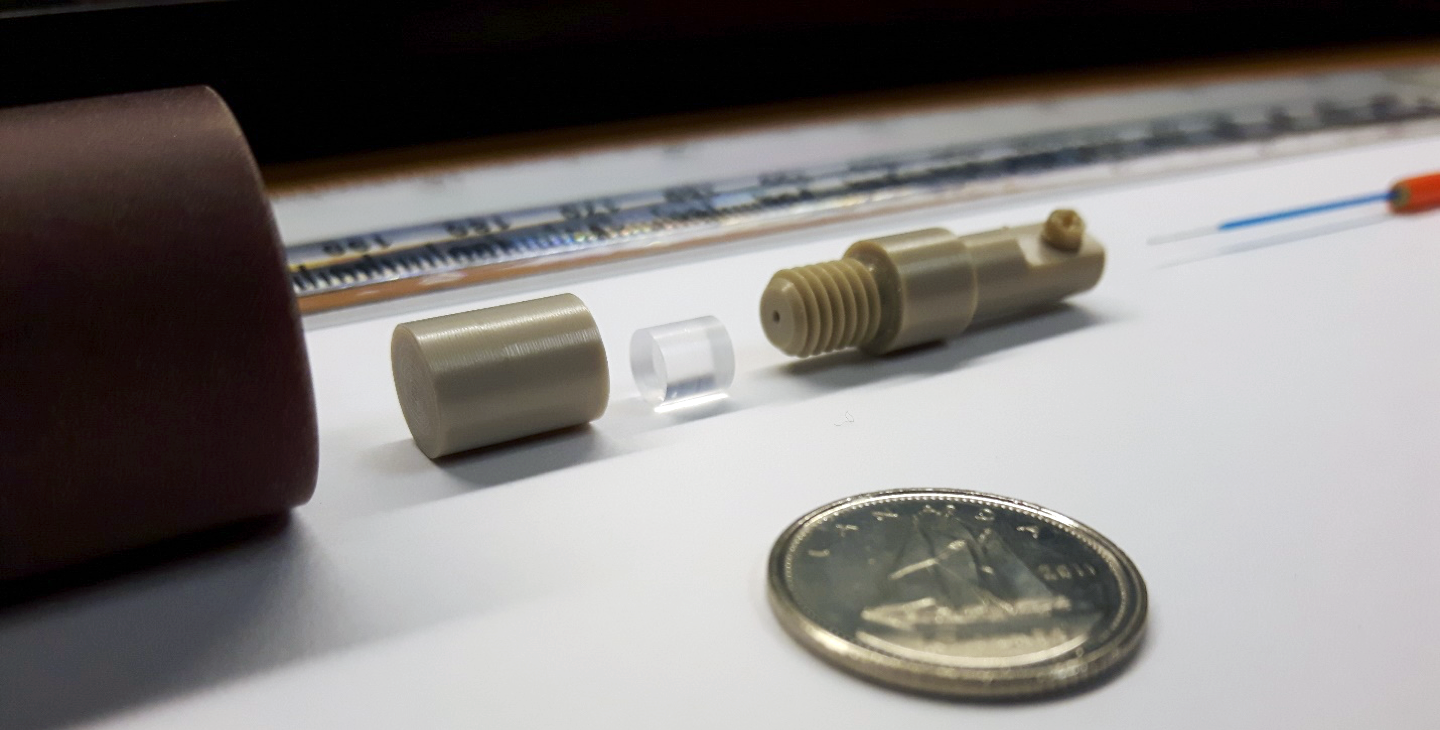Anthony J. MacKay Student Paper Contest Winner / Le gagnant du concours de communications étudiantes Anthony J. Mackay
Each year the Students and Young Professionals Committee organizes a student paper contest in conjunction with the CRPA annual conference. For more information, visit the CRPA website (http://crpa-acrp.org/home/?page_id=5295).
For 2018, instead of selecting one winner in advance of the conference, three finalists were selected to present their work at the conference. Each of the three finalists had their conference registration, travel, and accommodations provided courtesy of this year’s student contest sponsor, the University of Ontario Institute of Technology (UOIT).
The winner of this year’s Anthony J. MacKay Award is Humza Nusrat, a fourth-year PhD student at Ryerson University.

Résumé
La connaissance quant à la dose absorbée d’un rayonnement, en plus de sa qualité, c’est-à-dire de la capacité du rayonnement à endommager les tissus vivants, peut être très utile. En effet, en mesurant le spectre d’énergie, il est possible de connaître plusieurs caractéristiques de la source du rayonnement. Réciproquement, il est aussi possible de déterminer l’efficacité biologique relative maximale du spectre d’énergie. Cet article présente une nouvelle technique pour connaître le spectre d’énergie à l’aide de scintillateurs plastiques dopés. En effet, en ajoutant à des scintillateurs des niveaux variés d’éléments élevés en Z, le spectre d’énergie, et subséquemment le transfert énergétique linéaire ainsi que l’efficacité biologique relative, peuvent être connus au moyen d’une matrice de simulations de modèles et de l’appareillage de détection utilisés dans cette étude.
A novel method for resolving the energy spectrum of a radiation beam using doped plastic scintillators
By Humza Nusrat
Department of Physics, Ryerson University
Coauthors
Geordi Pang & Arman Sarfehnia
Odette Cancer Centre, Sunnybrook Health Sciences Centre
Toronto, ON
Introduction
Knowledge regarding the quality of radiation, the ability of radiation to cause damage to living tissue, in addition to absorbed dose can be very useful. The potential biological damage caused by low-energy X-rays or heavy charged particles can be many times more severe than the 1 MeV (or higher) photons typically used in cancer radiotherapy.
In cancer radiotherapy, absorbed dose is used to optimize the amount of radiation delivered to the patient, but does not account for variations in radiation quality (energy levels). Numerous studies have shown that the impact of low-energy scattered radiation on the radiation damage to the patient must be measured for optimal treatment. According to current literature, these low-energy particles may be causing more damage to tissue (by inducing cell death) than previously predicted.
In the radiation protection industry, a radiation-weighting factor (WR) is used to account for variations in radiation quality. However, these factors are often gross estimations.
By measuring the energy spectrum, many characteristics of the radiation source/beam can be resolved. Using the National Institute of Standards and Technology (NIST) collisional stopping-power database, the linear energy transfer spectrum can be obtained if the energy spectrum is known. Similarly, the maximum relative biological effectiveness can be determined from the energy spectrum, as shown by Nusrat et al. (2018).
This paper presents a novel technique for resolving the energy spectrum using doped plastic scintillators.
Methods
Plastic scintillators are made of organic materials that emit visible light upon interacting with radiation. Their response is intrinsically dependent on the stopping power of incoming radiation, as shown through Birks’ Law (Birks, 1964).
Using organometallic chemistry, various amounts of high-Z dopants can be incorporated into the scintillator volume. By adding high-Z elements, the radiation interaction cross-sections of the scintillator can be tuned in order to change its sensitivity to certain energy ranges (e.g., adding high-Z dopants can induce greater sensitivity to low-energy X-rays).
Four different scintillators were used: 0.0%, 1.0%, 1.5%, and 5.0% Pb–doped plastic scintillators (Eljen Technology, Sweetwater, TX). In order to resolve the energy spectrum, two main challenges needed to be overcome:
- We needed to account for a number of considerations when designing and fabricating the prototype.
- The responses of each type of scintillator to known photon energies needed to be determined.
The detector apparatus was constructed to allow the scintillator light to be guided via an optical fibre to a Hamamatsu H17021 photosensor module (design shown in Figure 1). Measurements were conducted at Sunnybrook Health Sciences Centre for high-energy (6, 9, 12, and 15 MeV electron beam) and low-energy (100, 180, 250, and 300 kV X-rays) radiation beams.

Figure 1: Scintillator detector shown in a disassembled configuration. Scintillator housing was constructed in house using poly(aryl-ether-ether-ketone) (PEEK), allowing for coupling to the optical fibre.
Based on the response of each scintillator to various monoenergetic energy bins, the response matrix (R) was created using Geant4 10.3 Monte Carlo simulations. The signal matrix (S) was obtained through measurements. Using these two pieces of information, the energy spectrum (∅) can be resolved:
∅ = S × R−1
Results
Each scintillator was modelled in Geant4 10.3, and the model was validated by comparing the light emitted by each scintillator in the simulated and measured cases. Through this, an accurate scintillator model was established.
The response matrix was created using energy bins of varying sizes; measurements were obtained using the detector apparatus. We discovered that doping with 5.0% Pb increased the sensitivity to low-energy radiation (100 kV X-rays) by 474% (± 0.78%) relative to the highest energy used (15 MeV electron beam). As the doping concentration was decreased, the low-energy sensitivity decreased significantly (141% ± 0.22% for the 1.0% Pb–doped scintillator). Using these measured and simulated results, the energy spectrum can be resolved.
Conclusion
In both radiotherapy and radiation protection, information regarding radiation quality is essential. By adding varying levels of high-Z elements to plastic scintillators, the energy spectrum and, subsequently, the linear energy transfer (LET) and maximum relative biological effectiveness (RBE), can be resolved using a simulated response matrix and the detector apparatus used in this study.
References
Nusrat, H., Pang, G., Ahmad, S.B., Sarfehnia, A. 2018. Evaluating the biological impact of increased scattered radiation in single and composite field radiation beams. Biomedical Physics & Engineering Express 4:035016. https://doi.org/10.1088/2057-1976/aab0db
Birks, J.B. 1964. The Theory and Practice of Scintillation Counting. Oxford: Pergamon Press.
 Humza Nusrat
Humza Nusrat
Humza Nusrat is a fourth-year PhD student in the Commission on Accreditation of Medical Physics Education Programs (CAMPEP)–accredited biomedical physics program at Ryerson University. His research work has focused on evaluating the variations in cancer radiotherapy using Monte Carlo simulations and the development of novel technology for the measurement of radiation effectiveness at Sunnybrook Health Sciences Centre. He is the vice-chair of the student councils of both the Canadian Organization of Medical Physicists (COMP) and the American Association of Physicists in Medicine (AAPM) Working Group to Promote Non-Clinical Career Paths for Medical Physicists.
Humza Nusrat en est à sa quatrième année de doctorat au programme de physique biomédicale de l’Université Ryerson accrédité par la Commission d’accréditation des programmes de formation en physique médicale (CAMPEP). Ses recherches portent sur l’évaluation des taux de variations en radiothérapie du cancer au moyen de simulations de Monte Carlo, de même que sur la création d’une nouvelle technologie de mesure de l’efficacité du rayonnement au Sunnybrook Heath Sciences Centre (Centre des sciences de la santé de Sunnybrook). Il est également le vice-président des conseils étudiants de l’Organisation canadienne des physiciens médicaux et du groupe de travail de l’American Association of Physicists in Medicine (l’Association états-unienne des physiciens médicaux) pour la promotion de carrières en physique médicale hors clinique.


 Humza Nusrat
Humza Nusrat